Black Copper and Richmond
Black Copper and Richmond (Richman)
Basin Deposits -Arizona - Copper
Overview
100% owned by Silver Bullet Mines
232 claims over almost 4900 acres plus a 15.5-acre patented claim plus a 65 acre patented millsite within 8 miles
In 2017 and 2018 a soil sampling program was carried out over roughly 10% of Black Diamond that returned areas of anomalous copper.
Copper Porphyry Potential
Potential Copper Porphyry with 3 copper / gold zones identified at the Black Diamond Property
– Richmond (Richman) Basin
– Buckeye South
– Black Copper
In 2017 and 2018 a soil sampling program was carried out over roughly 10% of Black Diamond that returned areas of anomalous copper. Expansion of the soil sampling program and standard exploration methodologies will help identify mineralization source and style.
In 2017 and 2018 a soil sampling program was carried out over roughly 10% of Black Diamond that returned areas of anomalous copper. Expansion of the soil sampling program and standard exploration methodologies will help identify mineralization source and style.

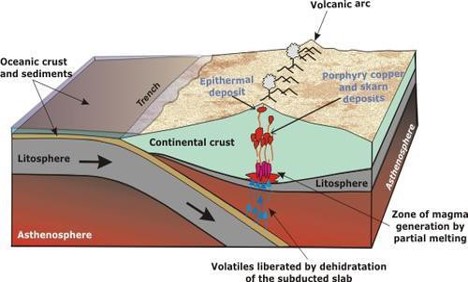
- As two tectonic plates push against each other, one plate is pushed down and under (Subducted).
The Subducted plate is heated (melted).
The solution rises silver (Ag) and gold (Au) and they are found along the edges.
Porphyry copper, skarn and epithermal ore deposits are the most common type of hydrothermal ore deposits. They are genetically linked to convergent tectonic margins characterized by calc-alkaline magmatism.
Porphyry copper deposits originate in or nearby porphyritic intrusives which were saturated by water as they intruded in shallow areas of the crust (less than 6 km depth). The developing hydrothermal systems are characterized by the interaction, to different degrees of fluids coming directly from the parental intrusive and from meteoric surface waters.
Ephitermal deposits form at depths of less than 1 km in a hydrothermal system dominated by surface waters with only a small contribution by magmatic fluids.
Skarn deposits form at the contact between intrusive rock and calcareous or clastic rocks which are rich in carbonate. The deposits occur on or near the margins of the intrusions and are the result of the replacement of the country rock by hydrothermal fluids carrying high metal concentrations outward from the intrusion. Frequently, the mineralization can be formed by the same fluids which concurrently formed porphyry copper deposits.
Soil Sampling at Black Diamond 2016 - 2018
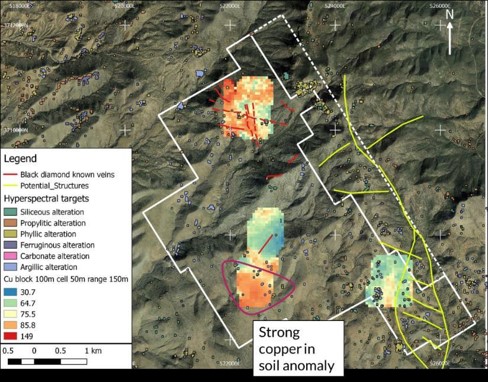
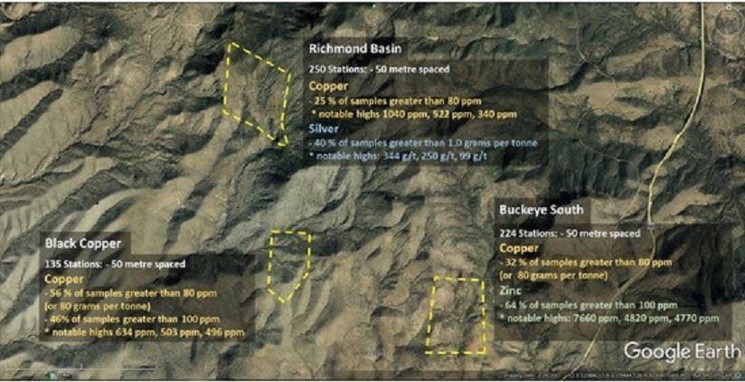
Kriging of the soil data highlighting the correlation between anomalous silver & copper values and past producing mines. Overlaying various survey (geological, geochemical, hyperspectral, etc.) highlight anomalous areas. Impressive geochemical results from the survey included elevated levels of silver, zinc and manganese. (pages 44 – 46 of current NI 43-101)
Soil sampling
The survey currently compromises of more than 800 samples from three prospective areas encompassing approximately 500 acres which include: (i) the Richmond Basin, site of recent delineated soil anomalies containing copper-zinc-manganese and is in close proximity to former zinc and manganese underground mines, and (iii) Black Copper where previous outcrop sampling yielded copper values up to 7%.
Initial results from the first 250 geochemical samples taken in the Richmond Basin area yielded anomalous copper values of 1,040 parts per million (ppm), 522 ppm, and 340 ppm along with silver values up to 344 grams per ton (g/t).
A second soil survey area consisting of 224 samples collected from the Buckeye South area returned exceptional results having both anomalous copper values of greater than 80 ppm and zinc values of 7,660 ppm, 4,820 ppm, and 4,770 ppm. Figure 2 depicts some of these anomalous trends.

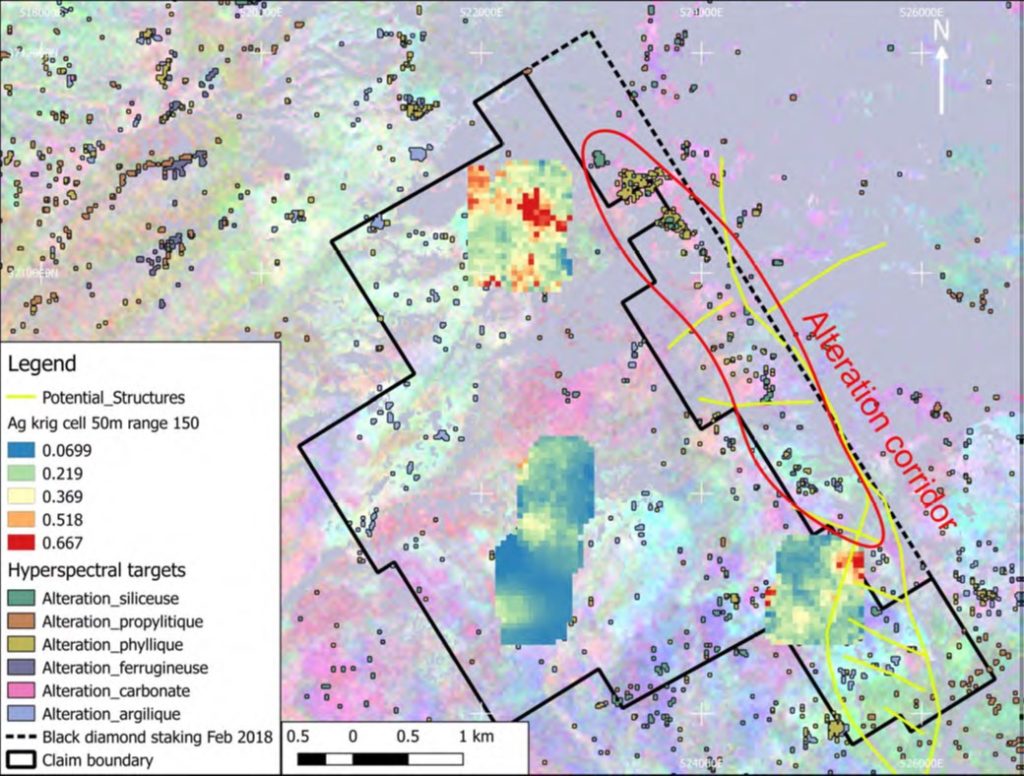
Hyperspectral Study
Hyperspectral study: successful reconciliation with know lithological units from USGS maps highlights multiple zones of alteration related to the porphyry and epithermal environments (propylitic, phyllic, argillic, etc.). Series of identified phyllic and argillic alteration zones located at intrusive contacts. Active staking adjoining pre-existing property in progress as of February 2018, 50 additional claims were staked to cover combined hyperspectral and soil anomalies, increasing land position by 25%.
Geochemical Survey
The Geochemical Survey recovered systematic soil samples on a 50-metre spaced grid. Each sample was submitted to ALS Laboratories for a 51 Element Aqua-Regia digestion and IPC-MS finish. The survey currently comprises of more than 600 samples from three prospective areas encompassing approximately370 acres: (i) the Richmond Basin and site of historic underground silver mines, (ii) Buckeye South, and (iii) Black Copper where previous outcrop sampling (outcrop samples were grab sambles selectively taken within the mineralized structure and therefore are not representative of the entire mineralization) yielded copper values up to 7%. Initial results from the first 250 geochemical samples taken in the Richmond Basin area delineated areas of anomalous (as defined by the values of the sample population greater than the 90th percentile) copper with some significantly anomalous results (exceeding the 98th percentile) as 1,040 parts per million (ppm), 522 ppm, and 340 ppm.
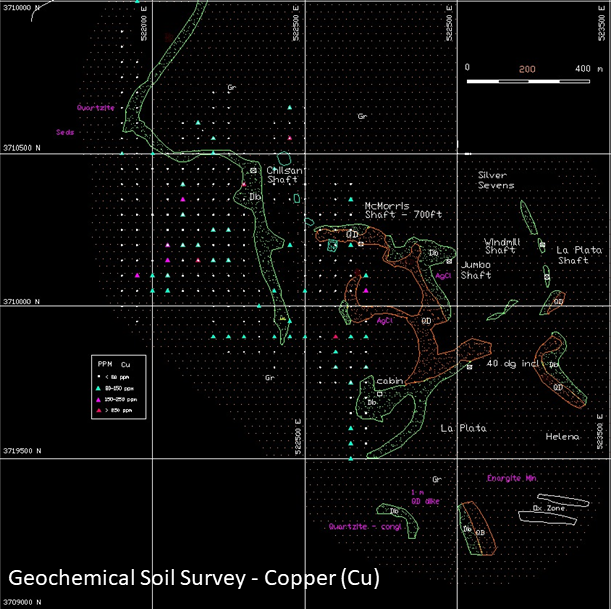
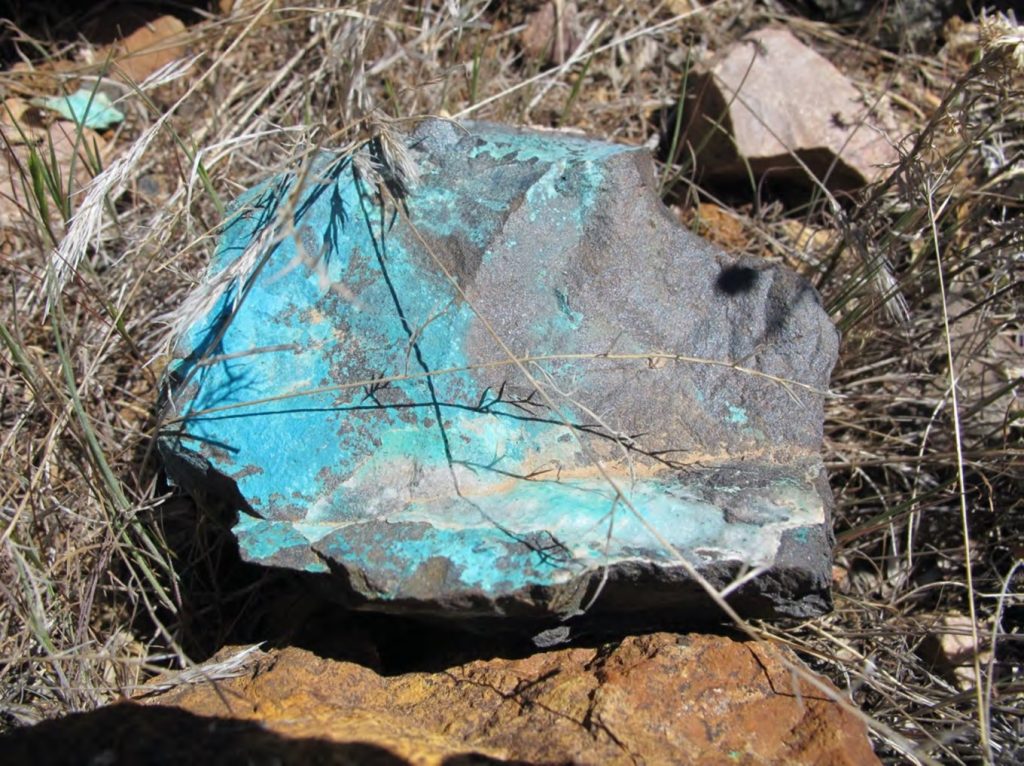
- More recent geochemical soil sampling from the Black Copper area yielded excellent results. Forty-six percent of the 135 samples collected at this location have copper results that exceed 100 ppm (or 100 g/t). Notable copper values that were strongly anomalous (greater than 97th percentile) analyzed from this location resulted in 634 ppm, 503 ppm and 496 ppm. Manganese levels indicated from the soil survey were anomalous with all sample results exceeding 100 ppm. Soil samples collected from the Black Copper area, all had manganese levels exceeding 200 ppm (72 soil samples were in excess of 1,000 ppm or 0.1%). Manganese, which is often found in association with other notable metals such as lead, silver, zinc, copper and vanadium has been mined in the Globe-Miami area. Although considered a “strategic mineral” in the United States, Manganese is predominantly sourced outside the United States, primarily from China and South Africa.
- In support of potential porphyry environment, O. M. Bishop mapped andesite porphyry in the Richmond Basin, while researching for his master’s thesis, ‘Geology and Ore Deposits Richmond Basin, Gila County’.
- The property is located up gradient from Freeport McMoRan’s porphyry copper mines ensuring soil geochemistry results are local to the claims.

